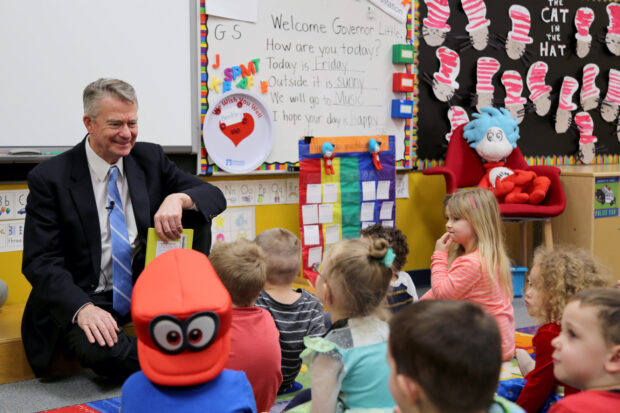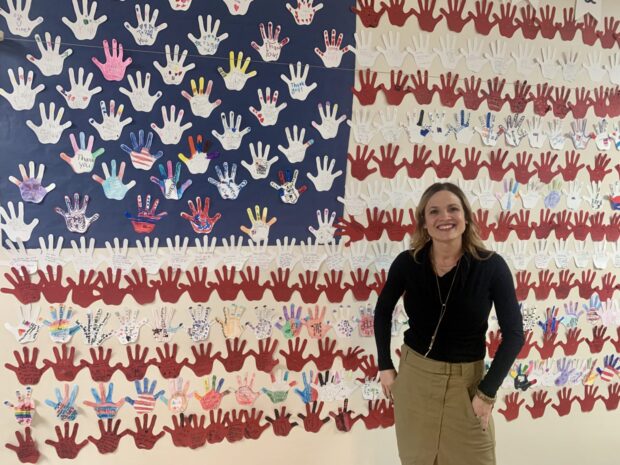Idaho Education News drilled down into the latest reading data to identify high-achieving schools and districts and ask the leaders of three of those schools what they’re doing, how they are doing it and what is working.
They all have different approaches, but one thing they all said is using a research-based curriculum is the first step. But ultimately, it’s about getting good teachers quality time with all students.
Last Friday, the State Department of Education released a detailed set of fall 2019 Idaho Reading Indicator scores and data. (Click here for the full list of fall 2019 IRI rankings).
At the top of the list, the only school where more than 90 percent of students hit grade-level benchmarks, was Compass Public Charter School elementary school. It’s an independent charter school serving 650 students located in Meridian.
Statewide, charters hold down all of the top nine spots based on the percent of K-3 students who hit grade level benchmarks.
The rankings run the spectrum, down to Wilder School District, where just 20.8 percent of students hit grade level benchmarks, meaning 79.2 percent of Wilder students did not hit grade-level benchmarks. Across the state, 54.7 percent of all Idaho students hit grade level benchmarks this fall.
North Idaho’s Kootenai School District was the highest performing district, with 72.1 percent of K-3 students hitting grade-level benchmarks. Idaho’s largest district, West Ada, outperformed other large districts by having 68.7 percent of its students hit grade-level benchmarks.

The Idaho Reading Indicator, or IRI, is an increasing important, closely-watched metric in Idaho. Gov. Brad Little has made early literacy his top priority and says there is no excuse for all children to be reading at grade level by the end of third grade. This year, Little and the Legislature doubled funding for the state’s literacy initiative and are spending $26 million on the program this year.
Earlier this month, Little’s education task force approved a recommendation to create a new school accountability system that focuses exclusively on growth IRI assessment scores, as compared between schools with similar demographic characteristics.
Compass Public Charter
State rank: No. 1, 90.6 percent of K-3 students hit grade level benchmarks
Compass co-founder and elementary principal Susan Luke said Compass’s own approach to mastery is what sets it apart and leads to high levels of achievement. Compass educators call the concept a spiraling curriculum. The idea is students are exposed to lessons and material over and over and over again — closely together in a tight, repetitive process like a spiral — so students understand the strategies, standards and concepts and develop a deep level of mastery.
“When we teach something, we don’t teach in chapters or units and then move on like a typical curriculum,” Luke said. “We come up with spirals and teach them repeatedly, very close to one another, so kids get lots and lots of opportunities to master content.”
There is also a team approach and alignment between the different grade levels, so kindergarten teachers know what skills students will need to be successful in first grade, and so on.
“If we’re teaching phonograms or phonemic awareness, we’re going to hit on that a little bit every day, all the way up until third grade, so kids are exposed to it over and over again so they have a chance to master them more deeply every time we hit on them,” Luke said.
Compass’s approach goes deeper than spiraling.
The school also focuses on students reading aloud, all the time. It may sometimes sound like chaos to a passing outsider, but it’s music to Luke’s ears.
“We do that all the time, every day, so our classrooms are full of students reading aloud,” she said. “We rarely do that thing where one student is reading at a time while everybody is listening. Engagement is at a higher level when the whole class is reading, it’s like a choral.”
Compass also invested in support for classroom teachers. Each kindergarten teacher now has an education assistant in the classroom full time. First, second and third grade classrooms also get significant support from education assistants. It allows the school to give more attention to more students and to focus on all students, not just those who are struggling readers.
“We made it important enough in our program that we budgeted for support for our teachers,” Luke said.
North Star Charter School
State rank: No. 2, 85. 1 percent of K-3 students hit grade level benchmarks
North Star Elementary Principal Shay Davis said the school’s success in reading has everything to do with getting the “backstage” set up right.

North Star is an Eagle-based charter school that serves 540 students at the K-5 level (there is also a middle school and high school) that has been in business since 2003.
For Davis and the North Star staff the successful backstage involved hiring a large number of paraprofessionals.
It involves mentorship.
It involves professional development for teachers.
It’s offering both half-day and tuition-based full-day kindergarten options.
And it meant realigning the school’s master schedule to focus on reading. Now, the master schedule includes one hour of core reading instruction, no matter what. On top of that, there is an additional 40 minutes of time blocked off for reading enrichments where paras and master teachers team up to focus on reading wherever students are at.
“We use all the data and that’s how we move the needle with our kids,” Davis said.
Students who are struggling are placed in smaller groups and matched with a highly qualified teachers on intervention.
But it isn’t just struggling readers who get extra attention. The school employs a similar approach to enrich high performing students, rather than allowing them to coast. There is an added benefit to breaking into smaller groups at the same time — it removes the stigma for struggling students because all students break into groups, not just some.
North Star also builds three hours of contractual time per month where teachers meet with “coordinators of success” who help educators process the data from iStation and to coordinate instruction.
“Most of the things we do cost a lot of money and took a lot of work, but it is paying off,” Davis said.
As the school grows, North Star has realigned its curriculum to focus on meeting students where they already are and moving the needle for all students.
“There is fear that comes with that and a vulnerability: are we going to stay high performing when we have changed what we’re doing?”
But, at the end of the day, it comes back to students. The lessons have to be fun and engaging. And the school celebrates nonacademic factors, like self-esteem, self-worth, good behavior and meeting goals.
“What’s different about North Star is the culture we create and how kids feel when they are in our building,” Davis said. “When you know you are cared for, that sets the stage for learning.”
West Ada School District
State Rank: No. 15, 68.7 percent of K-3 students hit grade level benchmarks
It almost sounds counterintuitive, but West Ada found success on the IRI by not focusing on the test itself, Superintendent Mary Ann Ranells said.

Instead, the state’s largest district focuses on placing highly effective educators in front of students. West Ada absolutely uses data and buys into it, but not in the way people might assume. The educators don’t focus on compassion data — you can beat your head against the wall comparing your school to others and picking a part where you fell short. Instead, they narrow the focus and use data to identify where extra support is needed for individual students. Then they use that data to design instruction and keep using data to ensure they are on track.
Overall, the district’s philosophy has four key pillars, Ranells said.
- First: Make sure we have clear learning targets for teachers and students, so both groups can say where they are.
- Second: Use very precise measure of what it is we wanted kids to know in their learning targets.
- Third: Use actionable data, to help identify where students might need additional time and support.
- Fourth: Use feedback to give kids an idea of where they in relationship to their targets. Ranells said that feedback inspires a sense of hope in students.
There is also something else, sometimes called the holy grail of alignment where the district wants to ensure: what is taught, tested, graded and reported all means the same thing.
Ranells also keeps things in perspective. The fall IRI, particularly for kindergarten, doesn’t measure what students learn in school. It measures the skills they have when they show up. And the IRI is only one metric of many, although it’s particularly useful in some regards.
“Data from fall IRI helps us, along with good, amazing classroom teachers, to identify students who needed additional time and support,” Ranells said. “Within the first few weeks of school we know right away. I know in a school district of over 40,000 this might not make sense but it is kid-by-kid, skill-by-skill.”
Don Nesbitt, the assistant superintendent of teaching and learning, can boil the district’s approach down to just a few words.
“It’s all students, no excuses, focused instruction,” Nesbitt said.
Idaho Education News data analyst Randy Schrader contributed research to this report.
Coming next month:
Idaho Education News senior reporter Kevin Richert will launch a weeklong series taking a closer look at Idaho’s literacy initiative and different districts’ approaches to reading.
